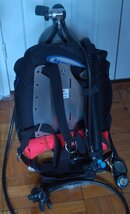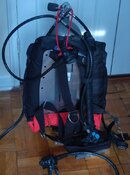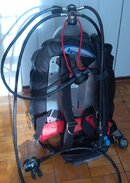Hi. I'm considering whether to replace my bc power inflator with one of those octo combinations.
I thought you hogarthian folks might have some valuable input as to whether or not this is a good idea.
My theory is that I can save one first stage regulator this way--I can have two first stage regulators configured for diving doubles, where one acts as the octo, when I'm doing fancy cold water wreck stuff. And when I travel to look at the pretty fishes and dive singles in shallow warm water, I can use one first stage regulator from the doubles rig and, without dorking around with hoses, the power inflator as octo.
I recognize that a potential downside to this is that I won't be able to use the power inflator hose on a lift bag, but I can't do that now since I have a zeagle bladder and figure I can use the dry suit inflator hose for that.
What do you think?
There are a few issues here.
1. What you are stating you want to do is to enable yourself to use one of your doubles regs as a single tank reg without changing hoses.
That means using either:
A. The first stage that is normally on the right post for your singles reg, but that would require moving the SPG from the left post to the right post, or
B. using the first stage that is normally on the left post and using the short hose as the primary and swapping your inflator to the left post.
Both of those ideas have serious problems that kill the idea even without consideration of the AIR 2. You are far better off investing in a third regulator to set up solely for singel tank diving and in the interim just swapping a hose or two.
2. A fundamental principle of hog diving is to leave everything that does not contribute to the dive in the dive bag where it can safely fail without affecting the dive. The other fundemental principle is streamlining.
In short, anything less than optimal is unacceptable.
3. The demands of deep, technical hard and soft overhead diving, and as a subset of this, cave diving, and the demands of non deco, non overhead diving water that is usualy less than 60 feet and always less than 130 feet are different.
To put this in perspective, Hogartian diving was developed by the WKPP specifically for cave diving and consequently this is very much a philosophy of gear configuration optimized for cave diving. However in the period of time since, DIR stole this gear configuartaion, expanded on it, and then went one step farther by asserting that the DIR configuration is ideal for any type of diving - something that was not originally or directly implied the WKPP.
Which brings us back to the hog golden rule - "anything less than optimal is unacceptable" raising the question of how "optimal" is a traditional hog rig to warm water mostly less than 60 feet and always less than 130 feet no deco, non-overhead recreational diving? And specifically what are the potential pros and cons of an Air 2 versus a bungeed octo in this recreational environment?
In this recreational environement any OOA emergencies are going to result in a direct ascent to the surface, so the potential limitation of breathing off an AIR 2 while swimming long distances underwater is not really an issue. Neither is the need to be able to access your backup second stage hands free in a restriction. A long hose primary is still ideal as it makes air sharing during an OOA event much easier and much less stressful even in this recreational situation. But it is less clear regarding the superiority of a bungeed octo versus an Air 2.
In terms of performance a high performance back up second stage will out breath the unbalanced AIR 2, but for the mission we are talking about (recreational non deco, non-over head diving at less than 130 ft) we are not going to 200-300 feet. The AIR 2's R190 style unbalanced poppet design is very reliable and offers performance that is more than adequate at 130 ft or above. The potential benefit for trading off the excess performance, is one less hose and better hose routing options which equates to improved streamlining.
In terms of complexity, the inflator and regulator functions of the AIR 2 are separate and in total are the same as an inflator and octo with the exception of having one less hose and associated o-rings. So it is a wash - except that should your Air 2 freeflow (which it is no more prone to do than a traditional octo like the R190 using the sae poppet design) you can disconnect it - not something that can be done with a traditional octo.
An argument can be made that using an AIR 2 requires some skill and practice to ascend while breathing and venting air. But most divers with any degree of proficiency at all who have taken any time to practice and are honest about it will agree it is not that hard, especially if a pull dump is used on the inflator assembly. While I would never consider using a pull dump on a technical diving wing where a failure point that high on the wing is a really bad idea, in this case (recreational single tank no deco, non-overhead diving in no more than 130 feet of water) I will have no problem swimming my rig up even with a total wing failure.
This is much the same difference as not using a computer on a technical dive - I'd use a traditional brass SPG, bottom timer, tables/software, etc. But ona recreational dive where the profiel is likely to be multilevel and multi dive/multiday in nature, a dive computer makes sense and it is not contraindicated as if it fails I have the direct ascent option with tables for backup.
Finally...look at the various hose routing options offerred and their impact on streamlining:
1. A non turret equipped first stage with 2 LP ports and an HP port per side (MK 16, Mk 17, Ledgend, Apeks, Posieden, etc.) mounted on it's side with an Air 2.
2. The ever popular with technical divers Scubapro angled type first stage (MK 5, Mk 10, Mk 15, Mk 20, Mk 25, Apollo, etc.) with a bungeed octo.
3. A non turret equipped first stage with 2 LP ports and an HP port per side (MK 16, Mk 17, Ledgend, Apeks, Posieden, etc.) with a bungeed octo.
That is the rank order in terms of streamlining with number one clearly being cleaner with no hoses extending outward and # 2 being decidedly better than #2 but with the bungeed octo hose still sticking out. The hose is box stock and could be shortened but it is still never going to be as clean as #1.
So...an AIR 2 is definitely not DIR as it does not conform to the one configuration for everything approach, and it is not something any self respecting hog diver would be caught dead with (and that could be very literally the case in a cave) but the idea does have merit in terms of being perhaps the most optimized configuration for shallow open water non deco diving where the cleaner hose routing equates to more streamlining and less potential for entanglement.
Whether you agree with that or not depends on the method you use to resolve the ethical dilemma that results from apllying the basic principles of hog diving in a recreational environment. If you use a authoritarian argument you will disagree, and you will also disagree if you apply the very DIR concept of using the same basic configuration in all situations (an important part of their philosophy that is not directly a hog philosophy) and also if you apply the implied "personal choice is bad" tenent of both DIR and Hog diving. But if you look at the underlying hog philosohy of "anything less than optimal is unacceptable' and then give serious consideration to what is really optimal in a recreational situation, you have to at least consider that an Air 2 may be a viable option.







